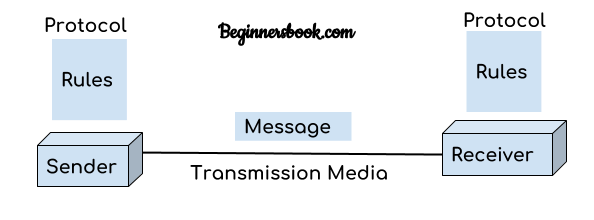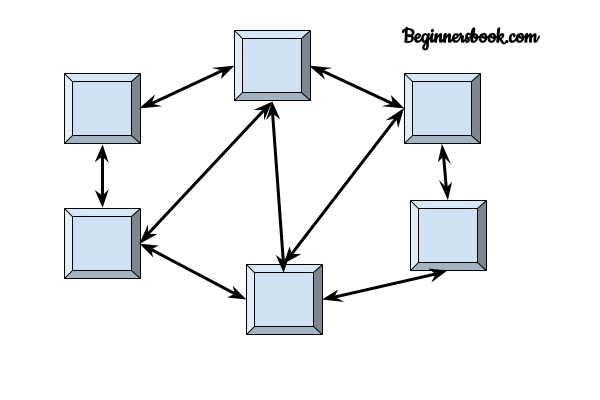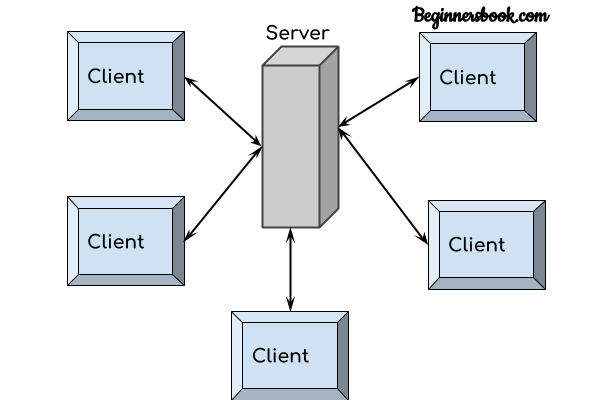A computer network is a group of devices connected with each other through a transmission medium such as wires, cables, etc. These devices can be computers, printers, scanners, Fax machines, etc.
The purpose of having a computer network is to send and receive data stored in other devices over the network. These devices are often referred to as nodes.
There are five basic components of a computer network

Message: It is the data or information which needs to be transferred from one device to another device over a computer network.
Sender: Sender is the device that has the data and needs to send the data to other devices connected to the network.
Receiver: A receiver is a device that is expecting the data from another device on the network.
Transmission media: In order to transfer data from one device to another device we need a transmission media such as wires, cables, radio waves, etc.
Protocol: A protocol is a set of rules that are agreed by both sender and receiver, without a protocol two devices can be connected to each other but they cannot communicate. In order to establish reliable communication or data sharing between two different devices we need set of rules that are called a protocol. For example, HTTP and https are the two protocols used by web browsers to get and post the data to the internet, similarly, the SMTP protocol is used by email services connected to the internet.
Features of a Computer Network

A computer network has the following features:
Performance: The performance of a computer network is measured in terms of response time. The response time of sending and receiving data from one node (computer in a computer network are often referred to as a node) to another should be minimal.
Data Sharing: One of the reasons why we use a computer network is to share the data between different systems connected with each other through a transmission media.
Backup: A computer network must have a central server that keeps the backup of all the data that is to be shared over a network so that in case of a failure it should be able to recover the data faster.
Software and hardware compatibility: A computer network must not limit all the computers in a computer network to use the same software and hardware, instead it should allow the better compatibility between the different software and hardware configuration.
Reliability: There should not be any failure in the network or if it occurs the recovery from failure should be fast.
Security: A computer network should be secure so that the data transmitting over a network should be safe from unauthorized access. Also, the sent data should be received as it is at the receiving node, which means there should not be any loss of data during transmission.
Scalability: A computer network should be scalable which means it should always allow adding new computers (or nodes) to the already existing computer network. For example, a company runs 100 computers over a computer network for 100 employees, lets say they hire another 100 employees and want to add new 100 computers to the already existing LAN then in that case the local area computer network should allow this.
Computer Architecture is a design in which all computers in a computer network are organized. Architecture defines how computers should get connected to get the maximum advantages of a computer network such as better response time, security, scalability, etc. The two most popular computer architectures are P2P (Peer to Peer) and Client-Server architecture.
Peer to Peer Architecture

In peer to peer architecture, all the computers in a computer network are connected with every computer in the network. Every computer in the network use the same resources as other computers. There is no central computer that acts as a server rather all computers act as a server for the data that is stored in them.
Advantages of a Peer to Peer Architecture
1. Less costly as there is no central server that has to take the backup.
2. In case of a computer failure, all other computers in the network are not affected and they will continue to work as same as before the failure.
3. Installation of peer to peer architecture is quite easy as each computer manages itself.
2. In case of a computer failure, all other computers in the network are not affected and they will continue to work as same as before the failure.
3. Installation of peer to peer architecture is quite easy as each computer manages itself.
Disadvantages of a Peer to Peer Architecture
1. Each computer has to take the backup rather than a central computer and the security measures are to be taken by all the computers separately.
2. Scalability is an issue in a peer to Peer Architecture as connecting each computer to every computer is a headache on a very large network.
2. Scalability is an issue in a peer to Peer Architecture as connecting each computer to every computer is a headache on a very large network.
Client-Server Architecture

In Client-Server architecture a central computer acts as a hub and serves all the requests from client computers. All the shared data is stored in the server computer which is shared with the client computer when a request is made by the client computer.
All the communication takes place through the server computer, for example, if a client computer wants to share the data with another client's computers then it has to send the data to the server first, and then the server will send the data to another client.
Advantages of Client-Server Architecture
1. Data backup is easy and cost-effective as there is no need to manage the backup on each computer.
2. Performance is better as the response time is greatly improved because the server is a more powerful computer than the other computers in the network.
3. Security is better as unauthorized access is denied by the server computer and all the data goes through the server.
4. Scalability is not an issue in this Architecture as a large number of computers can be connected with the server.
2. Performance is better as the response time is greatly improved because the server is a more powerful computer than the other computers in the network.
3. Security is better as unauthorized access is denied by the server computer and all the data goes through the server.
4. Scalability is not an issue in this Architecture as a large number of computers can be connected with the server.
Disadvantages of Client-Server Architecture
1. In the case of a server failure, the entire network is down.
2. Server maintenance cost is high as the server is the main component in this Architecture
3. The cost is high as the server needs more resources to handle that many client requests and to be able to hold a large amount of data.
2. Server maintenance cost is high as the server is the main component in this Architecture
3. The cost is high as the server needs more resources to handle that many client requests and to be able to hold a large amount of data.







0 Comments